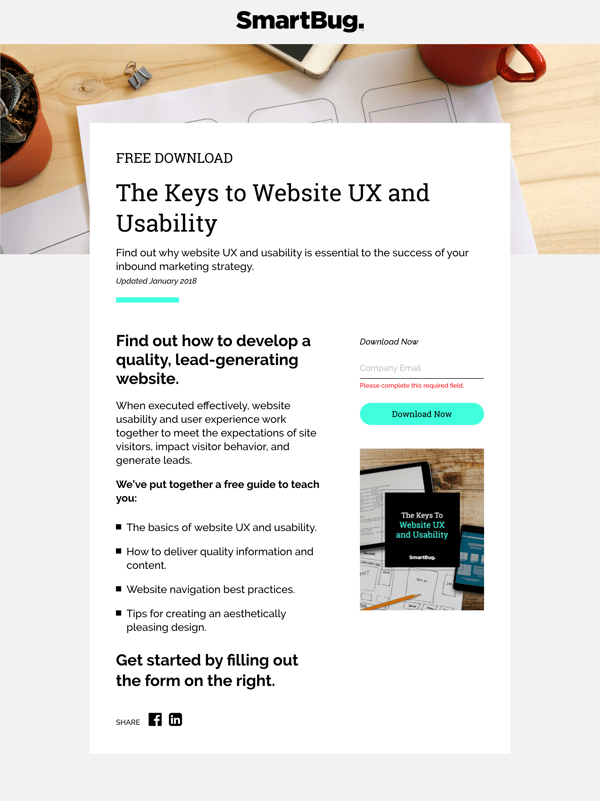
By Sandy Moore
Converting visitors into leads is the first step in creating a relationship between your company and a potential customer—and everything you need to know about what landing pages are and how they work is right here.
What Is a Landing Page?
A landing page is a page on your site that is designed to convert visitors into leads. It is different from other pages on your website in that it follows both of these criteria:
-
It has a form that allows you to capture a visitor's information in exchange for a desired offer.
-
The sole purpose of the landing page is to convert visitors into leads (a homepage with a form on it does not count as a landing page because it serves other purposes as well).
Simply put, a landing page is any page that has a form on it and doesn't include other distractions—here's an example:
If you remember anything from this article, remember that any page on your website with no navigation and a form used to convert visitors into leads is a landing page, and every site should have them.
How Do Landing Pages Work?
- A person sees a call to action and ends up on a landing page with a form.
- The person fills out a form, which converts them from a visitor into a lead.
- The information from the form fields is then stored in your leads database.
- You market to the contact or lead based on what you know about them.
If you use a marketing automation tool such as HubSpot, you’ll be able to see what offer the lead converted on, when they converted, and what other interactions they’ve had on your site. This information will allow you to nurture this lead in a more targeted way by helping you decide which marketing actions are most appropriate to take.
A nurtured lead is more likely to become a marketing qualified lead (MQL) and move through the marketing funnel faster. This helps show the return on investment (ROI) of your marketing efforts and keeps your sales team happy.
We use money every day to pay for goods and services, and the concept of monetary value can be applied to the logistics behind a landing page in that you’re exchanging equally valuable information no matter which side of the exchange you’re on. A visitor will fill out the form on the landing page because they believe the content they are accessing will be valuable to them, and a marketer will gladly give the piece of content to the site visitor because they can use the valuable information the visitor provides on the form in future marketing efforts. It’s a win-win situation.
The Conversion Process
Although the landing page is the main component of the conversion process, there are multiple assets that work together to make your conversion successful.
Calls to Action (CTAs): A CTA is an image or line of text that prompts your visitors to complete a specific action. On landing pages, CTAs tell the visitor where they should click to access the offer. CTAs can be found on pages of your website where the content correlates with your offer as well as on relevant blog posts that support the content within your offer. The more the CTA resonates with the landing page and other pages it is being promoted on, the more likely it is that a visitor will convert.
Landing Page: The landing page itself is home to the form that a visitor fills out in order to access the offer. As mentioned previously, its only purpose is to explain the benefits of a given offer and encourage visitors to convert into leads. Once the form is submitted, a visitor should be redirected to a “thank you” page.
Thank You Page: Although an in-line thank you message is available in most tools, it is recommended that you supply your new lead with a dedicated thank you page. Thank you pages include a “download now” button that new leads can click to get the download you offered on the landing page. In addition to hosting the offer, thank you pages are an excellent way to continue the conversion process and move the lead down the marketing funnel. Secondary offers (case studies, consultations, webinars, and more) should be shown via another form or specific CTAs on the thank you page to encourage the lead where to go next.
Want to know what building a website with us looks like? Watch the video below.
What You Need Before Creating a Landing Page
Before you can dive into building the landing page, you need to make sure you’ve done all of the background research needed to put it together effectively.
To do so, be sure to cover the following before you get to work on the landing page itself.
The Buyer Persona(s)
Buyer personas are semi-fictional representations of your ideal customers. They can be based on market research and current customer data. When done well, they can give you clear insight into your customers’ behaviors and how they think, which will allow you to develop the most valuable content you can for them.
When you create your landing page, it is important to target it to just one of your personas (if you have more than one). If you try to tailor the content on your landing page to multiple personas, it will inevitably not resonate with all of them and will decrease the odds of conversion. When you target one persona, your efforts will be much more focused and will increase your odds of conversion. It is better to be niche and focused than to attempt to appeal to the masses in this situation.
The Offer
An offer is something created to provide value to an organization's website visitors, aside from the products or services the organization sells. The offer could be a free e-book, webinar, tip sheet, comparison guide, or anything else that is downloadable and informative about the industry you are in. It should go hand in hand with a particular pain point your buyer persona is experiencing as well as their stage of the Buyer’s Journey (explained below).
The Buyer’s Journey
The Buyer’s Journey is the research process a potential buyer goes through leading up to a purchase. It can be broken into three different stages: the awareness stage, the consideration stage, and the decision stage. Different types of content should be created for each specific stage of the journey to help people move from one stage to another. Details of each are broken down below:
- Awareness Stage: A visitor in the awareness stage has expressed symptoms of a potential problem or opportunity but can’t quite name what that problem is. A person in this stage is doing a lot of research to understand their symptoms and define what is causing them. Pieces of content to create and target people in this stage include e-books, white papers, and guides.
- Consideration Stage: In the consideration stage, a prospect has clearly defined their problem or opportunity, and now they want to understand what they can do to solve it. Types of content you should create for people in this stage of the Buyer’s Journey include comparison white papers, webinars, and videos.
- Decision Stage (also know as the Intent Stage): In this stage of the funnel, the prospect knows their solution strategy and approach. At this point, they are doing vendor comparisons and are trying to narrow down the list of vendors to a select few before making their final choice. Providing them with case studies, demos, and product information at this stage would be a wise decision.
Building a Great Landing Page
Once you have the background research in place, it’s time to put the landing page together. However, there is a special recipe (put together and perfected by inbound marketers all over the world) that you should follow to increase your odds of conversion on the landing page.
Landing Page Best Practices
- Create a Compelling Headline: You need to develop a headline that will capture the visitor’s attention immediately and make them want to read on. It is the first thing they’ll see when they get to your landing page, and you don’t want it to be the last.
- Efficiently Convey the Value of Your Offer: Conveying the value of an offer concisely and effectively is crucial to the development of your landing page. Ever heard of the blink test? The blink test basically states that you need to convey your message and value before your visitor has time to blink—which means you have about 3-5 seconds. If you don’t do this successfully, you risk losing that conversion; it typically only takes one "blink" for someone to decide if they want to stay on your landing page or not.
- Include Bullet Points: For whatever reason, we humans like to mix things up, and we have short attention spans for things like landing pages. To keep your reader engaged, avoid writing lengthy paragraphs on your landing page. Instead, write a brief summary of the offer, and below the summary, list out bullet points of what the visitor can expect to read by downloading the material. Presenting this information as bullet points will keep the reader engaged while also giving them a preview of what’s to come, which can entice them to convert.
- Build the Form: When you create the form for your landing page, be mindful of the number of form fields you are including. The number of form fields you have should correlate with the stage of the Buyer’s Journey. Typically, for an awareness piece, you want to keep the forms brief and get basic information such as name and email address. The further down the funnel your content is, the more fields you should considering adding as leads are getting closer to buying. Once they’re at the decision stage, you’ll want to get more information from them to help the salesperson understand the contact better so they are better able to close the sale.
- Remove Site Navigation: When building your landing page, you want to remove any opportunity for your visitor to leave the page. By removing site navigation from your landing page, you allow your visitor to solely focus on the content at hand, rather than becoming distracted by other enticing links on your site.
- Insert Images: Who doesn’t love a good image? Be sure to include a relevant and engaging image on your landing page to draw the visitor in. People are more likely to stay on a page if a captivating image is present.
- Add Social Sharing Icons: Although you should remove all navigation from the landing page, it is important to include social sharing icons so that people can share the landing page with others across their social platforms. When you do this, however, be sure that when you click on the icon it opens in a new tab or window. You don’t want to redirect people away from the page, but you want to give them a clear option to promote it.
- Provide Testimonials When Relevant: These days, people are always looking at reviews of products and services before making a purchase, and this can apply to landing pages as well. But don’t include a testimonial that only vaguely ties into your offer. Make sure it directly correlates to what you’re promoting. If it doesn’t, it’s best to leave it off. The same advice goes for placing awards and accolades on your page.
- Make Sure Your Instructions on Next Steps Are Clear: A form on a landing page typically implies that you should fill it out, but be sure to include copy that suggests this on your landing page as well (typically near the end of your copy). This could be something as simple as, “To access the e-book, please fill out the form to the right.” It’s simple, but it gives your visitor clear instructions on next steps, which will make them more likely to convert.
Helpful Hints
Below are some pointers to consider that can make all the difference for your landing page:
- Proofread: We wish this was a given, but unfortunately, that’s not always the case. You need to look credible when somebody visits your landing page. If you mix up their and there, it looks sloppy and can deter people from converting. Triple-check everything on your landing page. If you know you’re bad at editing, ask someone else to do it. It’s important.
- Aim to Keep Your Copy Above the Fold: Although this isn’t a set-in-stone rule, the longer the copy on the landing page is, the less likely you’ll be able to keep somebody’s attention. Aim to be concise with your message and keep everything above the fold.
- Test Your Landing Page: Again, you’d think this is a given, right? It’s not. Once you’ve developed a CTA that links to your landing page and a thank you page that the landing page redirects to, test the full process. Click on the CTA, fill out the form, and download the offer on the thank you page. Make sure all steps are in place from a user's perspective, and confirm your contact info has been stored in the database to ensure everything is functional from a behind-the-scenes perspective.
Promotional Tips
Your job isn’t over once the landing page is complete. In fact, it has just begun. You need to get people to view your landing page—otherwise, what was the point of creating it? Below are top recommendations to promote your landing page.
- CTAs: As previously mentioned, CTAs are a great way to promote landing page content. Remember, the CTA needs to resonate with the content it lives on and with the landing page. The more cohesive these assets are, the more likely people will be to convert. Put the CTAs on site pages with a lot of visits that are relevant to the offer and in blog posts that support the offer.
- Email: Email is a great way to promote your landing page. Send a promo email to a targeted list as opposed to an entire email database. The more targeted the list is in relation to your landing page, the higher the odds are that people will convert. Don’t feel like you need to reinvent the wheel with this; a lot of the landing page content can be repurposed into emails.
- Social Media: As you’re probably aware, social is a great tool for spreading the word about your content. However, word to the wise: Don’t promote on every platform because that’s what you think you’re supposed to do. Select the few platforms where you know your personas are and promote heavily on those platforms. Don’t promote on a Facebook page just because everybody else is doing it—think about whether your personas are avid Facebook users. If not, you should probably look elsewhere.
Analyzing the Results
Once your campaign is up and running and traffic is being driven to the page, it is important to not just sit back, relax, and enjoy the show. Check in on the results of your landing pages frequently, but not excessively. You want to pay attention to trends and significant events that occur over a period of time rather than day-to-day traffic and conversion, which can range greatly and doesn’t give you a lot of usable and actionable data.
Here are other things to keep in mind when analyzing your landing page.
- Ask yourself, “Does my offer continue to perform well month over month?” If not, what changed?
- If you have a lot of different offers with landing pages, compare them against one another and see if you can figure out a pattern as to why some are performing better than others.
- If you have one landing page that is performing extremely well, re-promote that content and see if you can get an increase in contacts from that.
When you make changes to your landing pages (e.g., copy, images, form fields), be sure to change one thing at a time and test for a while. That way you can identify what specifically is affecting performance and single that out. If you change multiple things at one time, you won’t know which change or changes affected the landing page and won't be able to apply that knowledge toward future landing pages.
This post was originally published in August 2015 and has since been updated.

About the author
Sandy Moore Sandy Moore is a Senior Director of Account Strategy at SmartBug Media. She has more than 20 years of experience in marketing with extensive knowledge in outbound and inbound marketing, advertising sales, promotions, public relations, and sales enablement. Read more articles by Sandy Moore.









